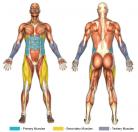Side Knee Raises (Hanging Straps)
- With the arm straps securely anchored, places arms into the straps.
- Lower the arms until they are resting in the straps.
- The straps are ideally positioned when above the elbow and slightly into the arm pit.
- Gently put your hands on the hanging part of the straps. Do not grip the straps tightly, as this can relieve weight from the abs.
- Rotating at the waist, point both your knees to the left or right (depending on what side you are working out) or alternate directions (not recommended) after each repetition.
- Bend your knees as much as possible, basically to the point that the heels of the feet touch the glutes.
- Keeping the straps parallel to the ground, slowly bring the knees in front of the chest, exhaling throughout the motion.
- Hold this position for 1-2 seconds.
- Slowly bring the knees back down to the starting position, inhaling throughout the motion.
- Switch knee orientation to opposite side (if alternating repetitions were not done).
- Repeat steps 7-9.
It is easy to get into a swinging motion with this exercise, but it's imperative that control is maintained throughout. Do not grip the straps as this may involve the arms in part of the lifting motion, thereby reducing the work done to the oblique and abdominal muscles.
Placing the hands on the straps is the best way to control the motion. Do this by placing your palms in towards you; it is ok to have a slight push on the straps but do not push so hard that it takes away from the abdominals doing the lifting.
The ideal position of the legs when in the 'up' position is one where your shins are in the middle of the body and your feet and knees are outside of the center. Imagine forming an equilateral triangle where your torso, feet, and knees are the three points.
As with other abdominal/core exercises, the ideal repetitions per set will generally fall within the 25-100 range.
Some prefer to alternate sides during the set. This is not the preferred method as it takes focus away from the side you are concentrating on. It can also add strain to the lower back when switching orientation.





